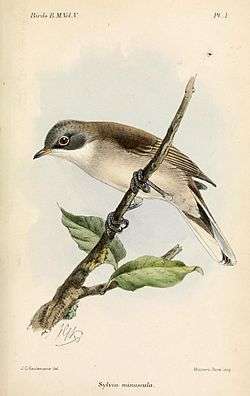Desert whitethroat
| Desert whitethroat | |
|---|---|
 | |
| Scientific classification | |
| Kingdom: | Animalia |
| Phylum: | Chordata |
| Class: | Aves |
| Order: | Passeriformes |
| Family: | Sylviidae |
| Genus: | Sylvia |
| Species: | S. minula |
| Binomial name | |
| Sylvia minula Hume, 1873 | |
| Synonyms | |
|
Sylvia curruca minula | |
The desert whitethroat (Sylvia minula) is a typical warbler. Until recently, it was considered conspecific with the lesser whitethroat; today these are seen as members of a superspecies. The desert whitethroat together with Hume's whitethroat form an Asian lineage in the superspecies, which have diverged into species adapted to drier lowlands and moister mountain habitats respectively.[2][3][4] [5][6] The name small whitethroat has also been used by some authors, and desert lesser whitethroat before it was split from lesser whitethroat.[2]
Description
It is distinguished from Hume's and lesser whitethroats by its smaller size (12 cm length, 8–13 g weight), smaller bill, the uniformly paler grey head lacking the well-marked dark cheeks of Hume's and lesser whitethroats, and a lighter grey-brown back; in these differences it follows Gloger's rule of pale colour in arid regions. The throat is white, and the rest of the underparts pale greyish-white.[2]
Taxonomy
Three subspecies are currently recognised,[7] though some authors only accept the first two as distinct.[2]
- Sylvia minula minula (syn. S. m. chuancheica). Western half of the species' range.
- Sylvia minula jaxartica (included in S. m. minula by some authors[2]). Central part of the species' range.
- Sylvia minula margelanica. Eastern half of the species' range.
The presumed lesser whitethroat subspecies halimodendri and telengitica might actually belong to the desert whitethroat, or alternatively might represent hybrid intergrades between, respectively, S. m. jaxartica and S. m. margelanica and the lesser whitethroat.[8]
Range and migration
Desert whitethroat inhabits arid lowland regions from eastern Iran and Turkmenistan eastwards to Xinjiang in central China, breeding in open dry thorn scrub. The breeding range does not overlap with lesser whitethroat, occurring to the southeast of that; it does overlap geographically with Hume's whitethroat but is separated altitudinally. The desert whitethroat migrates south to the Arabian Peninsula, southern Pakistan and northwestern India in the winter, where it does overlap with wintering lesser whitethroat in many areas, and more locally with wintering Hume's whitethroat.[2] Vagrant is Sri Lanka, recorded in single time.
References
- ↑ BirdLife International (2012). "Sylvia minula". IUCN Red List of Threatened Species. Version 2013.2. International Union for Conservation of Nature. Retrieved 26 November 2013.
- 1 2 3 4 5 6 Del Hoyo, J., Elliot, A., & Christie, D. (editors). (2006). Handbook of the Birds of the World. Volume 11: Old World Flycatchers to Old World Warblers. Lynx Edicions. ISBN 84-96553-06-X.
- ↑ Helbig, A. J. (2001). The characteristics of the genus: Phylogeny and biogeography of the genus Sylvia. Pages 24–28 in: Shirihai, H., Gargallo, G., Helbig, A. J., & Harris, A. Sylvia Warblers. Helm Identification Guides ISBN 0-7136-3984-9
- ↑ Jønsson, K. A., & Fjeldså, J. (2006). A phylogenetic supertree of oscine passerine birds (Aves: Passeri). Zool. Scripta 35 (2): 149–186. doi:10.1111/j.1463-6409.2006.00221.x (HTML abstract).
- ↑ Helbig, A. J. (2001): Phylogeny and biogeography of the genus Sylvia. In: Shirihai, Hadoram: Sylvia warblers: 24-29. Princeton University Press, Princeton, N.J. ISBN 0-691-08833-0
- ↑ Jønsson, Knud A. & Fjeldså, Jon (2006): A phylogenetic supertree of oscine passerine birds (Aves: Passeri). Zool. Scripta 35(2): 149–186.doi:10.1111/j.1463-6409.2006.00221.x
- ↑ IOC World Bird List
- ↑ Snow, D. W., Perrins, C. M., Doherty, P., & Cramp, S. (1998). The complete birds of the western Palaearctic on CD-ROM. Oxford University Press. ISBN 0-19-268579-1
